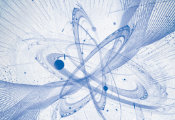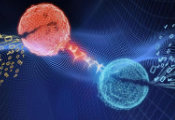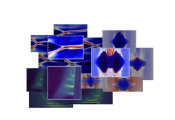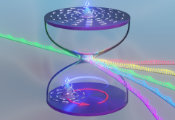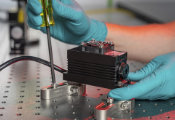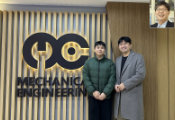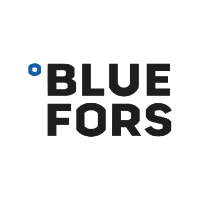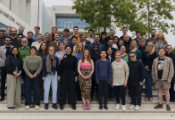A Symphony of Light and Atoms
September 22, 2025 -- Imagine a symphony that never stops. The musicians are atoms, the concert hall that lets their sound build is an optical cavity, and the skilled conductor is a new continuous loading with strong coupling technique—keeping perfect time, seating new players quietly mid-performance, and blending everyone into one steady, pure tone. The 'music' you hear is the single, coherent laser beam emerging from the cavity.
In this experiment, supporting laser beams cool and move the atoms—think of them as the metronome and stage crew, not the performance itself. The performance is the new light the atoms collectively create inside the ring cavity, which then exits as a continuous laser. With this conductor-like control, Professor James K. Thompson, a Fellow of JILA, NIST and the Department of Physics at the University of Colorado, Boulder, and his team, maintain both continuous operation and strong collective coupling between the atoms and the cavity, a key step toward ultra-stable light sources and precision measurement tools.
In a set of papers, published in Nature Physics and Physical Review Letters, the Thompson group demonstrated continuous loading and strong coupling of strontium atoms to a high-finesse optical ring cavity, and continuous recoil-driven lasing with an unexpected pinning of the cavity frequency.
Vera Schäfer, one of the lead researchers, explained, "The original goal of our experiment was to build a continuous superradiant laser, a tool which allows us to make high precision frequency measurements at short timescales. This could help us to explore different regimes to search for dark matter and other new physics."
Zhijing Niu, the graduate student noted, “We managed to realize continuous laser cooling of strontium atoms into an optical ring cavity and to transport them within the cavity. This allowed us to keep a steady stream of extremely cold atoms, which is essential for building a continuous superradiant laser."
Thompson added, "But along the way we found something very curious and unexpected that reflects the fact that nature has a way of self-organizing when you pump energy into a system. We saw laser light coming out of our system when we were just trying to load a very cold gas of atoms between the highly reflective mirrors that form our laser cavity."
Continuous Lasing: Quantum Light Sources
Lasing, or light amplification by stimulated emission of radiation, is a process familiar to many through everyday devices like laser pointers and barcode scanners. Past lasing realized with laser-cooled atoms often involve pulsed operation, where the light source is intermittently active. In contrast, continuous lasing provides a steady stream of coherent light, which is crucial for applications requiring high stability and precision.
The researchers utilized laser-cooled strontium atoms, which were continuously loaded into a high-finesse ring cavity. This setup allowed for the atoms to be trapped and cooled using a series of laser cooling stages, including a three-dimensional red molasses and a vertical slowing beam. The continuous nature of this process ensures that atoms continuously replenished, crucial for sustained lasing.
Niu explained, "We have figured out how to laser cool and load our atoms continuously rather than staggered in time like almost all other experiments in our field do (i.e., cool and load some atoms, briefly do some science, throw them away, repeat).” Thompson added, “However, even before getting a chance to use the very narrow atomic transition, we saw laser light coming out of the cavity, and it would keep going all day long until we went home for the day!"
Recoil-Driven Lasing: The Heartbeat of Quantum Light
To understand recoil-driven lasing, think of a game of pool. When the cue ball strikes another ball, it transfers its momentum, causing the second ball to move. Similarly, in recoil-driven lasing, photons (light particles) transfer their momentum to atoms, causing them to move more quickly. This movement creates a population inversion, a key requirement for lasing.
In traditional lasers, achieving population inversion often involves complex setups and intermittent operation. However, the researchers at JILA have developed a method to maintain this inversion continuously. By using laser-cooled strontium atoms and a high-finesse ring cavity, they have created a system where the atoms are constantly replenished and kept in a low-energy state. This continuous replenishment ensures that the lasing process never stops.
Thompson noted, "We realized that the lasing involved absorbing a photon and then undergoing stimulated emission (the s and e of LASER) to a different momentum state since the atom recoils when it catches a photon of light and then throws it into the cavity.” Niu added, “This appears to be the gain mechanism provided by nature when we put energy into the system via our laser-cooling beams."
Strong Collective Coupling: Enhancing Atom-Cavity Interactions
In addition to continuous lasing, the study also achieved strong collective coupling of strontium atoms to the optical cavity. This phenomenon occurs when the collective interaction between the atoms and the cavity field is strong enough to significantly alter the properties of the system. The researchers demonstrated this by observing continuous atom-cavity vacuum Rabi splitting, a clear indication of strong coupling. This effect is akin to a dance where the atoms and the cavity photons are in perfect sync, leading to new and exciting quantum behaviors.
Schäfer highlighted, "A lot of the physics we saw only happens because this is a continuous rather than a cyclic experiment. The most interesting lasing regime only appears when starting in a noisier state, and then slowly changing the cavity parameters to a less stable regime that is only upheld by the continuous lasing."
Cavity Frequency Pinning: Stabilizing the Quantum Orchestra
One of the challenges in maintaining continuous lasing and strong coupling is the sensitivity of the system to external disturbances. Any fluctuation in the cavity frequency can disrupt the delicate balance, much like a sudden noise can throw an orchestra off-key. To address this, the researchers discovered a new mechanism that pins or stabilizes the resonance frequency of the cavity. Schäfer notes, “[we] found out that without us even trying, this lasing mechanism stabilized the effective frequency of our cavity.”
Cavity frequency pinning involves stabilizing the frequency of the dressed cavity mode to match the frequency at which there is gain for light inside the cavity. This is achieved through an atomic loss mechanism that adjusts the number of atoms in the cavity based on the lasing intensity. When the cavity frequency drifts, the system automatically compensates by altering the atom number, keeping the cavity frequency and hence the lasing frequency stable.
"This gain mechanism also causes atom-heating which then causes a funny feedback loop that keeps the effective optical cavity frequency to a fixed value, even when we tried our darndest to change the cavity frequency," Thompson explained.
The Future is in Narrow Linewidths
The continuous lasing and strong collective coupling achieved in this study represent an important milestone in laser and quantum science. These advancements not only enhance our understanding of fundamental quantum interactions but also open the door to a wide range of practical applications.
Thompson shared their next steps, "Many different groups in atomic and laser physics are moving towards continuous rather than cyclical operation, whether it be for quantum computing or for ultranarrow linewidth lasers. We plan to really use the narrow linewidth transition in strontium to build incredibly single-color lasers to explore the world."
Soon, this technology could lead to the development of ultra-stable superradiant lasers with millihertz linewidths, which are crucial for high-precision measurements and tests of fundamental physics. Additionally, the techniques developed in this study could be applied to create new quantum sensors and devices that leverage the unique properties of continuous atom-cavity interactions. By orchestrating a tightly synchronized ensemble of atoms and light under conductor‑like control, researchers are not only pushing the boundaries of what’s possible but also laying the groundwork for the next generation of quantum technologies.
This research is supported by the U.S. Department of Energy, Office of Science, National Quantum Information Science Research Centers, Quantum Systems Accelerator, the National Science Foundation JILA Physics Frontier Center and Q-SEnSE QLCI, and the Humboldt Foundation.

